Beautiful Cascais on the Portuguese coast is just 40 minutes from Lisbon. Royalty has holidayed here and it’s easy to see why. There are so many fun things to do in Cascais: from beach-hopping to boat trips, cultural fixes to kite-surfing. Here’s a guide to what to do in Cascais, plus the best Cascais hotels and info on how to get from Lisbon to Cascais.
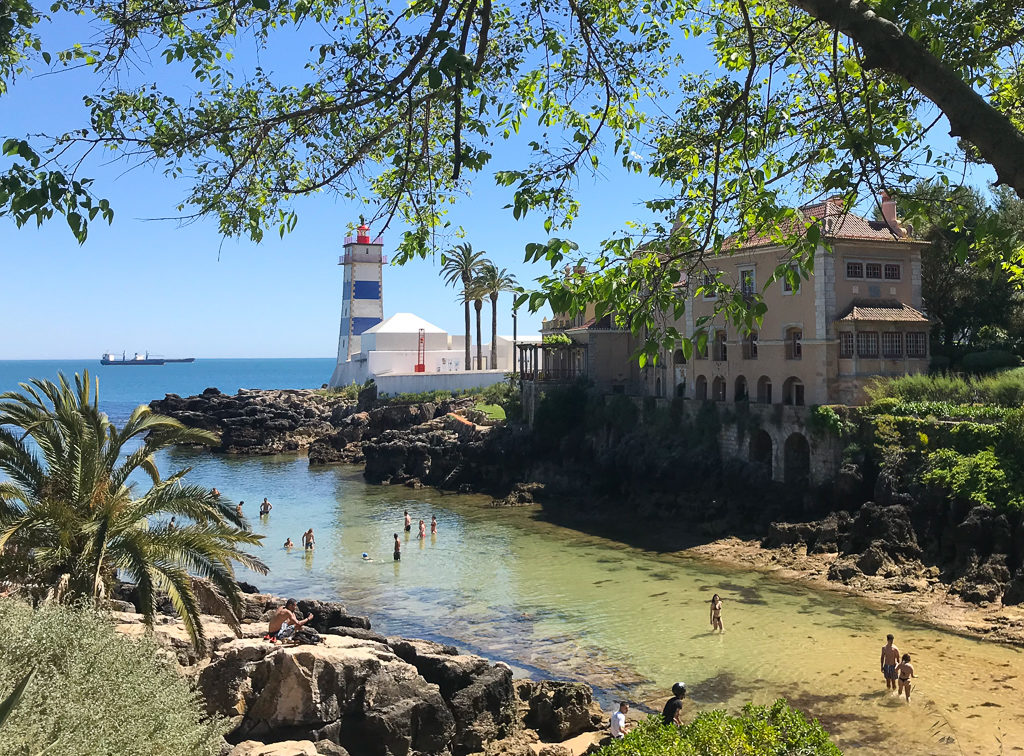
This post contains affiliate links, this means that I may receive a commission at no cost to you if you click a link and make a purchase.
The elegant seaside town of Cascais lies just along the coast from Lisbon. It’s neat as a pin yet full of character with its black and white mosaic pavements, decorative tiling and fishing boats bobbing in the harbour. It’s a favourite day trip from Lisbon but it’s also a charming base for a visit in its own right.
Back in 1870 it was just a quiet little fishing village until the Cascais beaches caught the eye of the Portuguese king, Luis. Improved roads from Lisbon meant that Cascais was suddenly within range as a summer getaway, and King Luis loved to be by the sea.
He built a palace beside the fortified citadel and the aristocracy followed his lead with lavish summer mansions. Europe’s high society heard about it and Cascais soon became an early, upscale holiday resort.
One hundred and fifty years later Cascais is still a jewel in the crown of the Portuguese Riviera. Although it’s becoming ever more sophisticated, Cascais has kept its small town character and glamorous fin de siècle villas, whilst its beaches are as lovely as ever.
Whether you’re visiting on a day trip from Lisbon or planning what to do in Cascais on a longer stay, here are my top things to do in Cascais Portugal.
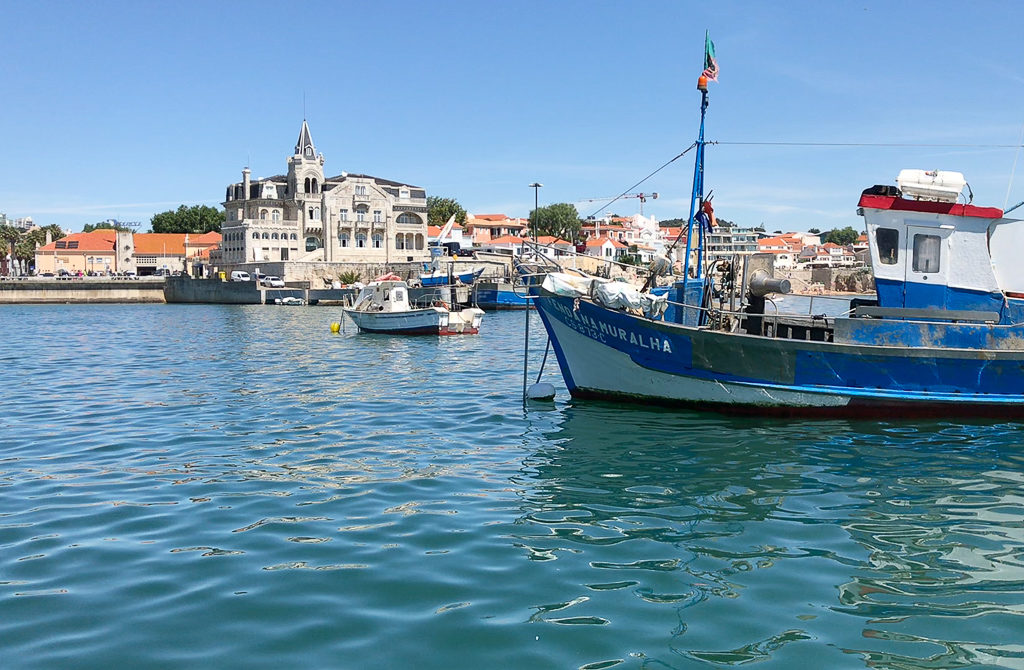
How to Get to Cascais Portugal
First things first. Cascais is only 30 minutes by road from Lisbon airport, making it an easy long weekend or short break destination from the UK. All four London airports: Heathrow, Gatwick, Luton and Stansted offer direct flights to Lisbon which take around 2 hr 45 mins. And they’re also available from Bristol, Birmingham, Edinburgh, Liverpool and Manchester.
Several US airports have direct flights to Lisbon too. The flight time from NYC to Lisbon is around 7 hours.
Lisbon airport to Cascais
Getting to Cascais from Lisbon airport is super-easy. The coastal town of Cascais is only 30 km from Lisbon and 36 km from Lisbon international airport.
I arrived at Lisbon airport in the evening and took the Aerobus direct to the Cais do Sodré train station in Lisbon. I did have to wait a while for the bus but they run every 20 minutes between 7.30 am and 11 pm. The journey took around 45 minutes and a single ticket was €4.
I could have taken the metro instead, with one change, but this would have taken roughly the same amount of time.
A taxi to the Cais do Sodré train station from Lisbon airport takes 10 minutes and costs around €10.
Lisbon to Cascais by train
At Cais do Sodré train station I caught the commuter train from Lisbon to Cascais which takes around 40 minutes. Trains run from Lisbon to Cascais every 12 minutes at peak times, then every 20 or 30 minutes at other times of day. A single ticket is a bargainous €2.40.
However, there is a snag. Although the station was quiet on the evening I used it, it is apparently crowded, with long queues for tickets, during high season. And since the Lisbon Cascais train is an urban line, tickets cannot be pre-booked. So bear that in mind when planning your journey.
The train from Lisbon to Cascais follows a coastal route, stopping at beaches along the way. Sadly at 10pm that evening it was dark, and I couldn’t see outside. But make a point to sit on the left hand side on your way to Cascais, then on the right hand side on the way back to Lisbon: that way you’ll see the coastal views in daytime.
My journey from Lisbon airport to Cascais by bus and train cost just a few euros in total. But it did take one hour 30 minutes from the airport to our apartment in Cascais.
Taxi from Lisbon to Cascais
Alternatively, my friend Freya arrived at Lisbon airport at lunchtime that same day. She took a taxi direct from Lisbon airport to Cascais. This cost around €30 and took 40 minutes.
Ultimately, a transfer by car, booked in advance to meet you from the airport, is the quickest and easiest way to travel from Lisbon to Cascais.
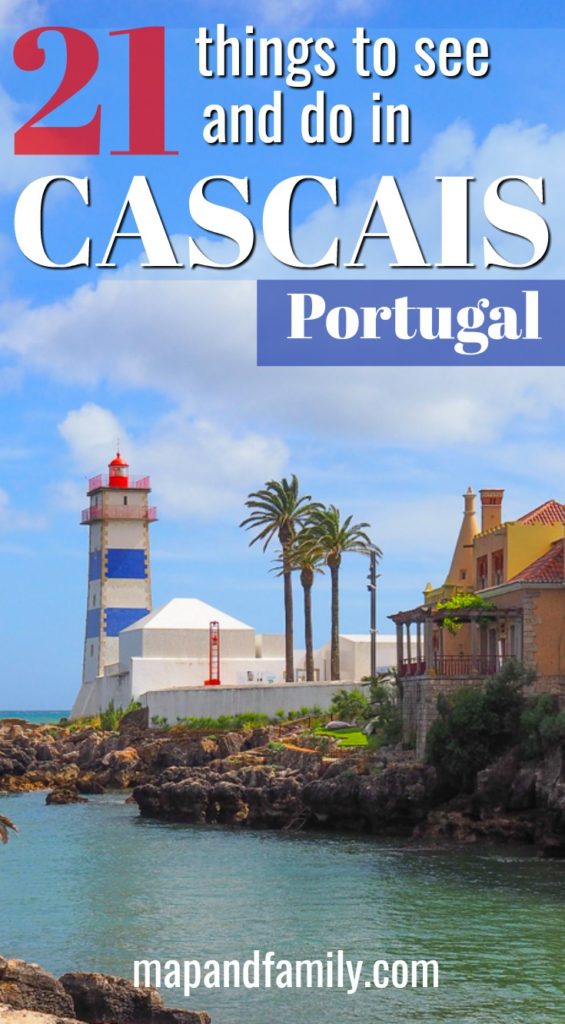
26 Fun Things to Do in Cascais
Freya visits her family in Cascais regularly and when she suggested a springtime trip I jumped at the chance to go too. Sure enough, after five days of exploring its beguiling mix of seaside charm and fascinating history, I can understand why everyone loves this town. Here are our top picks of fun things to do in Cascais Portugal.
1. Relax on a Cascais beach
Cascais doesn’t just have one or two beaches, its coastline has seventeen. And thanks to its location, between the Tagus river estuary and the Atlantic, there is quite a variety. The beaches to the west of town which face the ocean are buffeted by strong winds and currents making them a magnet for pro surfers. But the stretches of sand between Cascais and Lisbon are altogether quieter, more sheltered and suitable for family and relaxation.
Since the local Lisbon to Cascais train stops at the beaches en route, it’s easy for visitors to sample a different beach everyday. To reach the Atlantic beaches to the west and north of Cascais you’ll need to either drive, take a bus (there’s one roughly every 30 minutes from Cascais) or hire a bicycle and follow the coastal bike path.
These are some favourite Cascais beaches:
- Praia da Conceição is close to the station with a wide stretch of sand and calm waters for paddling or paddleboarding.
- Praia da Rainha is a pretty cove tucked away in the centre of town. Once Queen Amélia’s private beach, it is nowadays very popular and likely to get crowded in high season.
- Praia de Santa Marta is a tiny beach between the Marina and Palácio dos Condes de Castro Guimarães with a magical lighthouse view. The small stretch of sand only really appears as the tide goes out.
- Praia do Tamariz is the main Estoril beach which you can reach by train or walking along the promenade. It also has a sea water swimming pool, Piscina Oceãnica do Tamariz, where the water is a little warmer than the ocean.
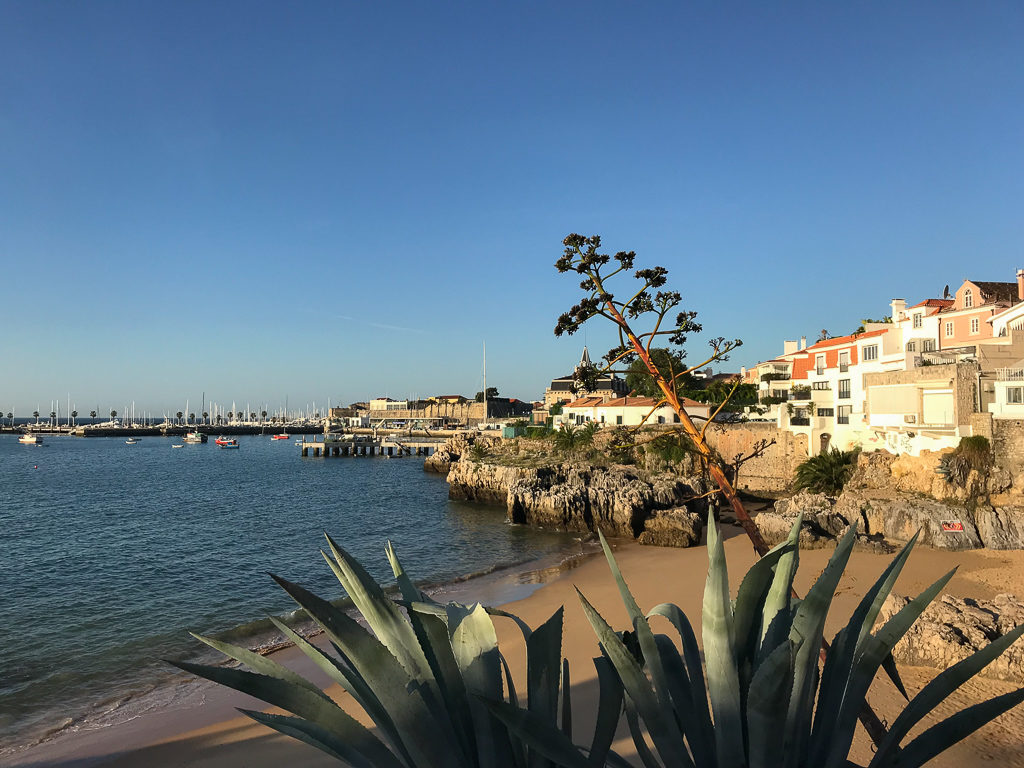
2. Take a Cascais boat trip
A great way to get an overview of the beautiful coastline and local beaches is to take a Cascais boat trip. It’s a chance to see the iconic Cascais views from a completely different perspective. We set out on a calm and sunny day so we were able to experience a sailor’s eye view of the Boca do Inferno cliffs as well as the Santa Marta lighthouse. Then our boat turned east along the coast towards Lisbon and Torre do Bugio, the fortified lighthouse in the estuary.
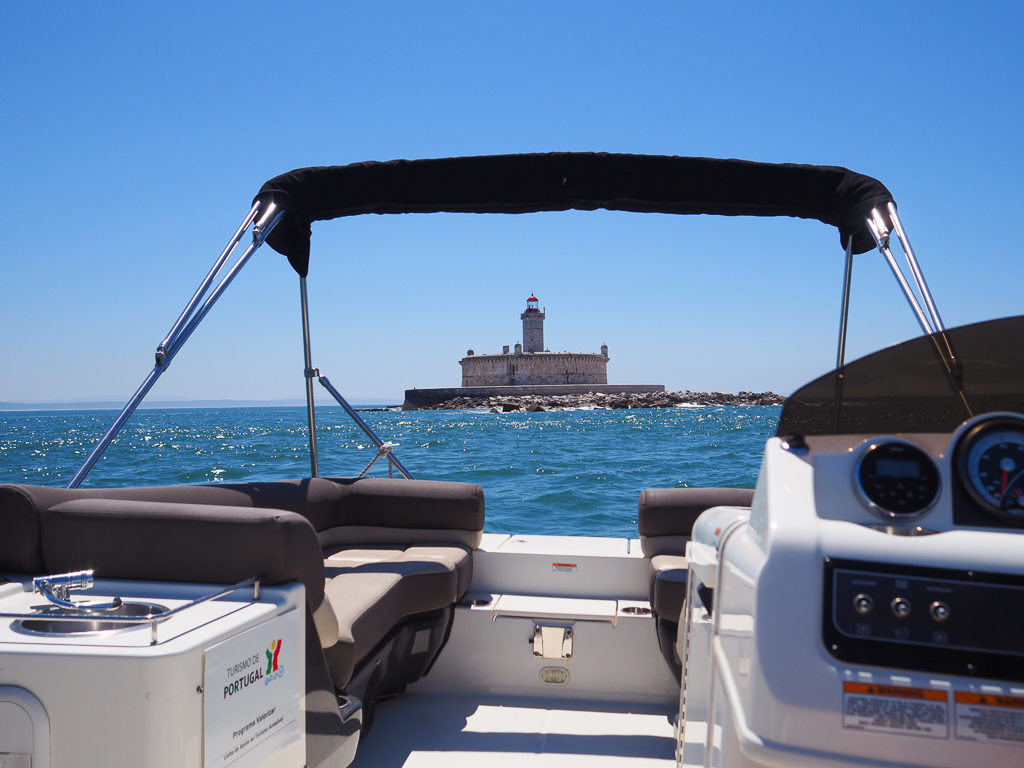 From the sea it’s easy to spot the different characters of the local beaches and their levels of busy-ness. A boat trip is a really fun way to make the transfer to or from Lisbon to Cascais as well. Contact Aquastart.pt for more information on boat tours and transfers.
From the sea it’s easy to spot the different characters of the local beaches and their levels of busy-ness. A boat trip is a really fun way to make the transfer to or from Lisbon to Cascais as well. Contact Aquastart.pt for more information on boat tours and transfers.
Where to stay in Cascais
Just check out some of these gorgeous Cascais hotels. From chic boutique to historic fortress, there is something for everyone in this town and prices are affordable too.
Here are some of the best Cascais hotels that are all well-reviewed and in memorable locations. You can check below for prices, availability and to book:
The Albatroz Hotel
An up-scale and elegant historic hotel in the centre of Cascais with beaches and local restaurants within walking distance. It’s still peaceful though with sea views from its private balconies as well as a pool and terrace overlooking the beach. Check here for reviews, availability and to book
Pestana Cidadela Cascais
A modern luxury 5 star hotel within a converted historic fortress with an Art District on site. Wonderfully situated overlooking the marina with the town and beaches all within walking distance – if you can tear yourself away from the rooftop pool and spa. Check here for reviews, availability and to book
The Pergola Boutique Hotel
A very pretty mansion in the heart of town. Once a traditional family home it still retains that vibe with beautiful gardens, antique furniture and just 15 rooms. The decor has an up-to-date boutique feel. Adults only. Book early! Check for reviews, availability and prices.
Villa Cascais Boutique Hotel
A 19th century residence overlooking the fishermens beach in the centre of town. Villa Cascais has been reborn with a design look: rooms are monotone in bold shades of blue or olive green. Fab sea views, a hip bar and restaurant and affordable prices! Check here for reviews, availability and to book
Onyria Quinta da Marinha Resort
This luxury resort in the Sintra-Cascais Natural Park on the edge of town has its own 18 hole golf course. Two swimming pools, two restaurants – organic vegetables are grown on site – and a spa and wellness centre. 3.4km to Cascais. Check here for reviews, availability and to book
Hotel Fortaleza do Guincho Relais & Châteaux
Built on the site of a 17th century fort overlooking Guincho beach, this grand 5 star fortress hotel has traditional stone staircases, cloisters and vaulted brick ceilings. There’s a Michelin star restaurant too with views over the wild and expansive Guincho beach. 6 km to Cascais. Check here for reviews, availability and to book.
More Cascais Things to Do
3. Eat fresh fish in Cascais
Cascais started life as a fishing village and and fishing boats are still moored in the town centre harbour. This was my view when I woke up early one morning and went for a walk.
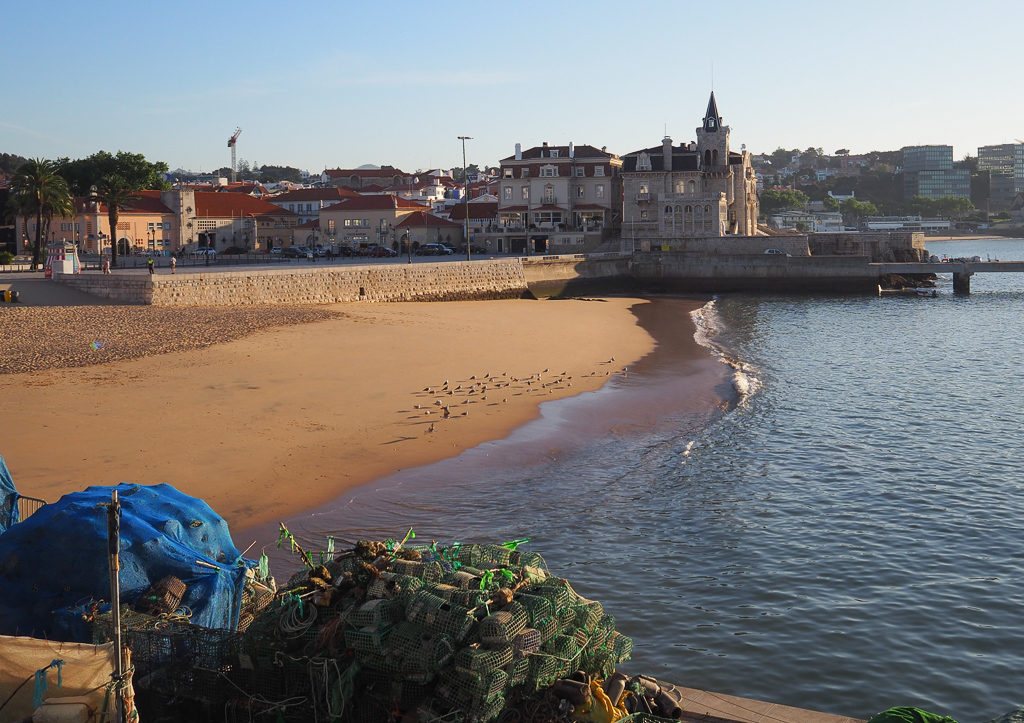
The catch is sold twice a week at the market and the local restaurants offer plenty of fish dishes. On our first day, after a stroll around the marina, we had lunch at Marisco where we shared a piece of fresh robalo or sea bass, chosen from their display of fish and sold by weight.
Later in the week, we ate at Gordinni’s at the marina, with a lovely view of the Santa Marta lighthouse. Gordinni’s serves Italian food and also has local specialities on its menu. We chose octopus with olive oil, garlic and baked potatoes and fresh bream, grilled and served with sauteed vegetables. Other local favourites are cod with cream, Bulhao Pato clams cooked with white wine and Arroz do Mar which is a rice dish with shrimps, clams and mussels.
4. Walk along the promenade from Cascais to Estoril
A wide seafront promenade, the paredão, links Cascais to the nearby town of Estoril. It’s a Cascais must see and a lovely walk that hugs the coastline above the sands and sea defences. We set off late one afternoon to have a look at the beautiful beaches and the views.
After about 3km we decided it was far enough to warrant a stop at a beachside bar. As the shadows lengthened we drank caipirinhas at Estoril’s beach, Praia do Tamariz (and were thrilled that they cost half the price they would in London). Afterwards we retraced our steps to Cascais, although we could have easily hopped on the coastal train to go home instead. The walk takes around 30 minutes each way.
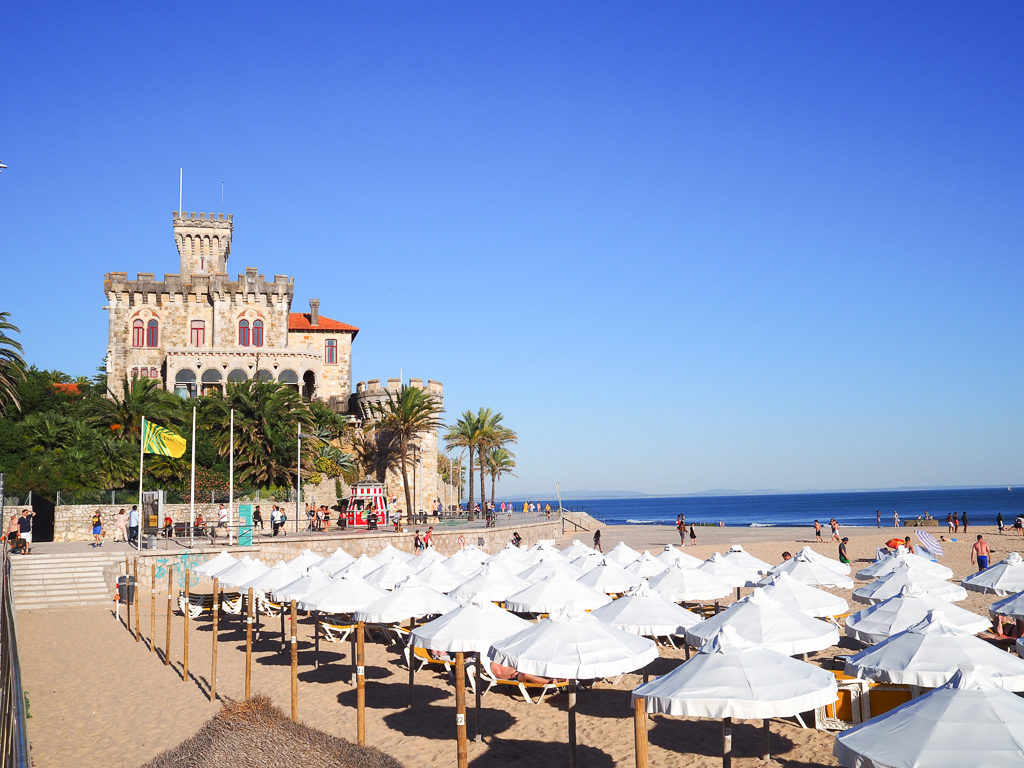
I wish we’d had a bit more time to explore Estoril. It was a hotbed of intrigue during WW2 when Portugal was neutral and spies from both sides lurked in neighbouring hotels beside the grand casino. Ian Fleming stayed there on a work trip for the Intelligence service. He was inspired to write Casino Royale, and the rest is history. Don’t miss the chance to use the Instagram-ready mobile phone holder that frames the view of ornate Chalet Barros.
5. Explore Cascais Old Town
Well-swept and tidy with wafting palms and neat rows of bedding plants, Cascais has a well-heeled air, without being brash or glitzy. It’s done a wonderful job of holding onto its heritage whilst moving decisively into the 21st century.
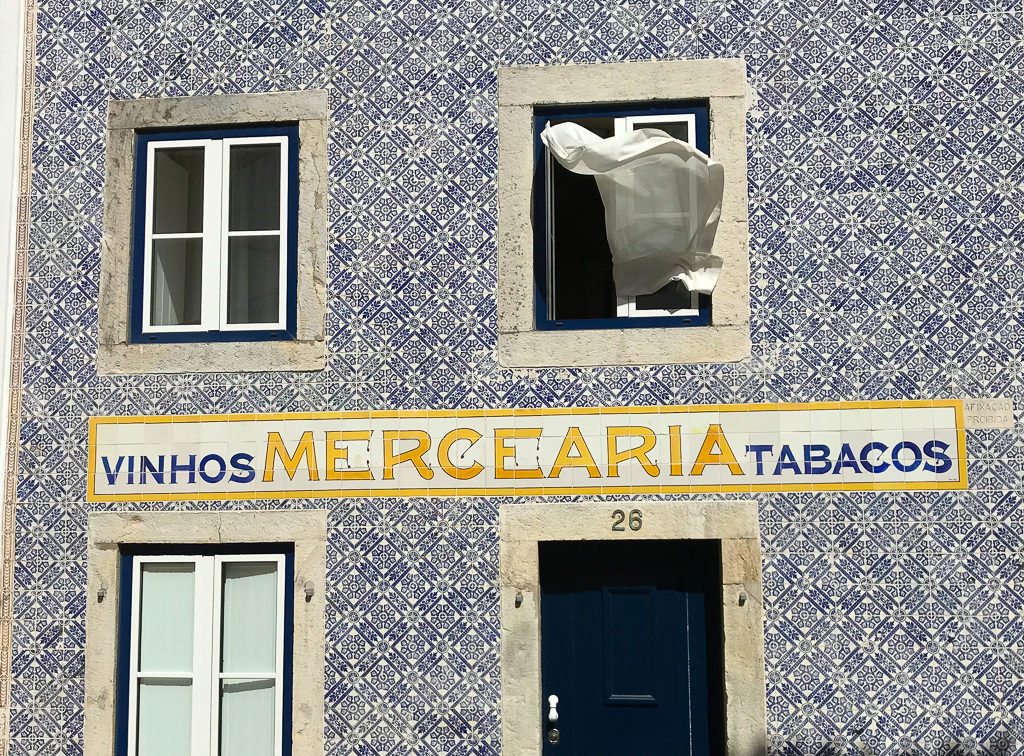 Exploring the old Town is one of the best things to do in Cascais. One minute you can be wandering through the pastel painted streets, admiring wall tiles and billowing bourganvillea. The next, you might pass a pile of workaday fishing nets as you round the ramparts of the 15th century citadel which is now a chic hotel.
Exploring the old Town is one of the best things to do in Cascais. One minute you can be wandering through the pastel painted streets, admiring wall tiles and billowing bourganvillea. The next, you might pass a pile of workaday fishing nets as you round the ramparts of the 15th century citadel which is now a chic hotel.
From there it’s just a few more steps to a marina of glossy pleasure boats and restaurants. If that wasn’t enough, there are historic villas to visit, a park with peacocks and a whole cultural quarter to explore. It’s a great mix with always something interesting to explore.
6. Taste Portuguese pastries in Cascais
The sweet Portuguese custard tart, or Pastel de Nata, is world famous. In fact they were first made by monks in Lisbon. But Portugal has hundreds more recipes for sweet pastries.
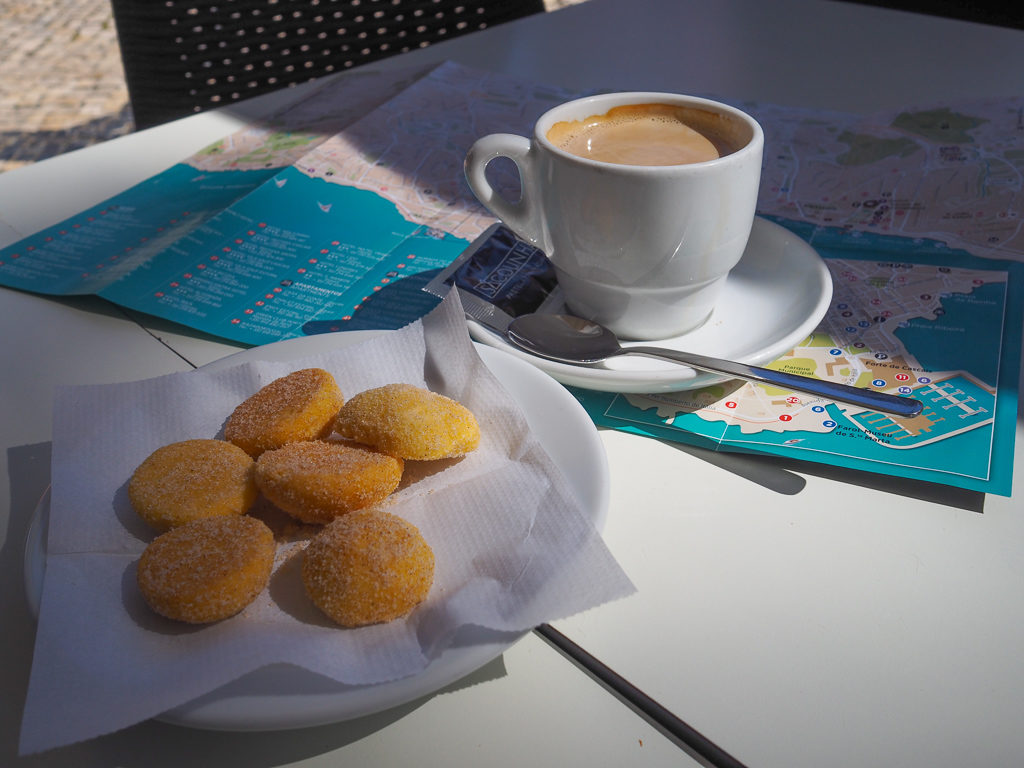 Many towns, including Cascais, have their own local recipes. It dates back to the time when egg white was used for starching linen. In the monasteries, monks and nuns used the yolks left over from their laundry to make and sell pastries. After the dissolution of monasteries in 1834 the monks carried on their craft in order to earn a living, so baking became a local industry.
Many towns, including Cascais, have their own local recipes. It dates back to the time when egg white was used for starching linen. In the monasteries, monks and nuns used the yolks left over from their laundry to make and sell pastries. After the dissolution of monasteries in 1834 the monks carried on their craft in order to earn a living, so baking became a local industry.
Nowadays Cascais pastry shops sell plenty of sweet treats to tempt you with your morning coffee. Try simple Areias or deliciously almond’y Jesuitas de Amêndoa at Bijou de Cascais next time you’re visiting Cascais.
7. See the Cascais street art
We didn’t have to go far to find street art. We came across several big vibrant images that reference the town’s seafaring history. It’s one of the fun free things to do in Cascais
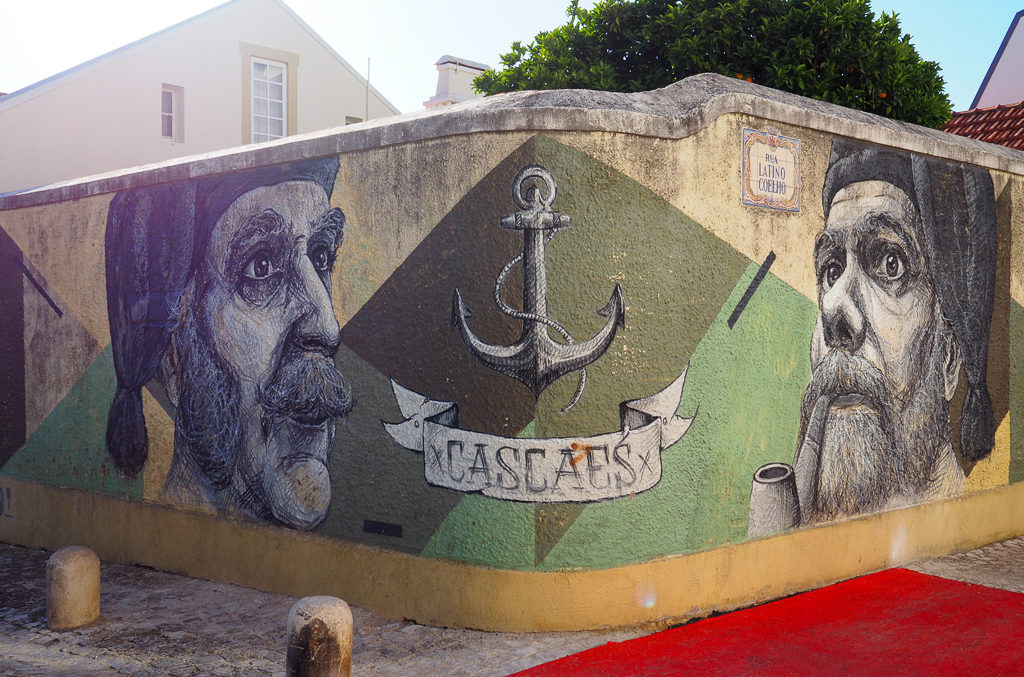
8. Browse the boutiques
I could easily have spent all day browsing through Cascais’s quirky selection of shops. If you’re looking for souvenirs then you’ll be surprised by exactly how many accessories can be made from cork. It’s one of Portugal’s biggest exports. You’ll find cork mats, hats, handbags, phone pouches and even ties in the shops around Cascais’s square.
Ceramics and painted tiles are another favourite buy, but you’d be missing out if you thought that was all Cascais has to offer.
Roam the network of cobbled streets to find artisan makers, boutiques and homeware stores as well as international designers. On the west side of town, Casa da Guia is a clifftop mansion on the Guincho road. Inside you’ll find tempting shops and an art gallery. It has outdoor cafes and lovely views too.
9. Take a closer look at the Cascais pavements
The pavements and pedestrianised squares in Cascais are like little works of art. The swirling patterns of black and white cobbles reminded me of the beachside pavements in Rio de Janeiro.
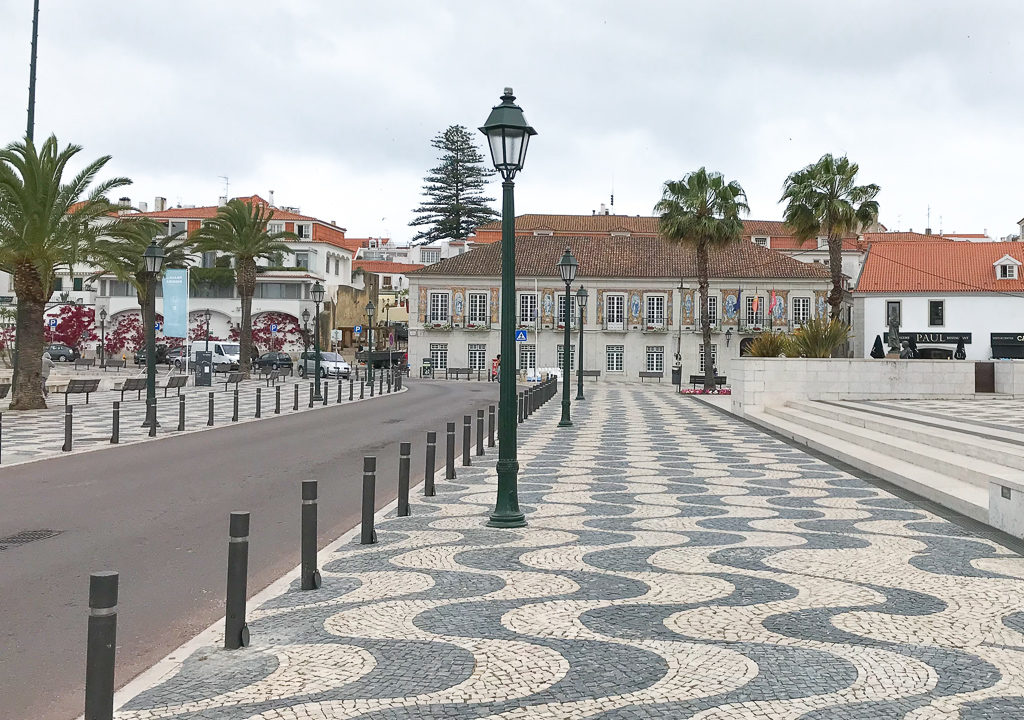 Since Brazil was once a Portuguese colony it took inspiration from the tiled streets and squares of Lisbon. The style is called calçada portuguesa and dates from the 14th century. Even today the patterns are still painstakingly laid by hand and they swirl and twirl into the little streets around the main square.
Since Brazil was once a Portuguese colony it took inspiration from the tiled streets and squares of Lisbon. The style is called calçada portuguesa and dates from the 14th century. Even today the patterns are still painstakingly laid by hand and they swirl and twirl into the little streets around the main square.
10. Try a heritage ice cream
An ice cream from Santini’s, is a Cascais must do. It’s one of Portugal’s finest historic ice cream parlours. Flavours change daily, all are secret recipes and they’re served in homemade cones. Top tip: the strawberry is legendary.
11. Visit the Cascais market
Mercado da Vila sells fish, fruit and flowers and has an eating plaza too with an array of restaurant and take-away options. Best days to visit are Wednesdays and Saturdays when local sellers from the region set up their stalls.
12. Climb the Santa Marta lighthouse
Thanks to its strategic position, en route to the port of Lisbon, the area around Cascais boasts several historic lighthouses and fortresses. The prettily striped Santa Marta lighthouse, built in 1867, is a photographer’s dream. But it still has a day to day role in signalling along the coastline.
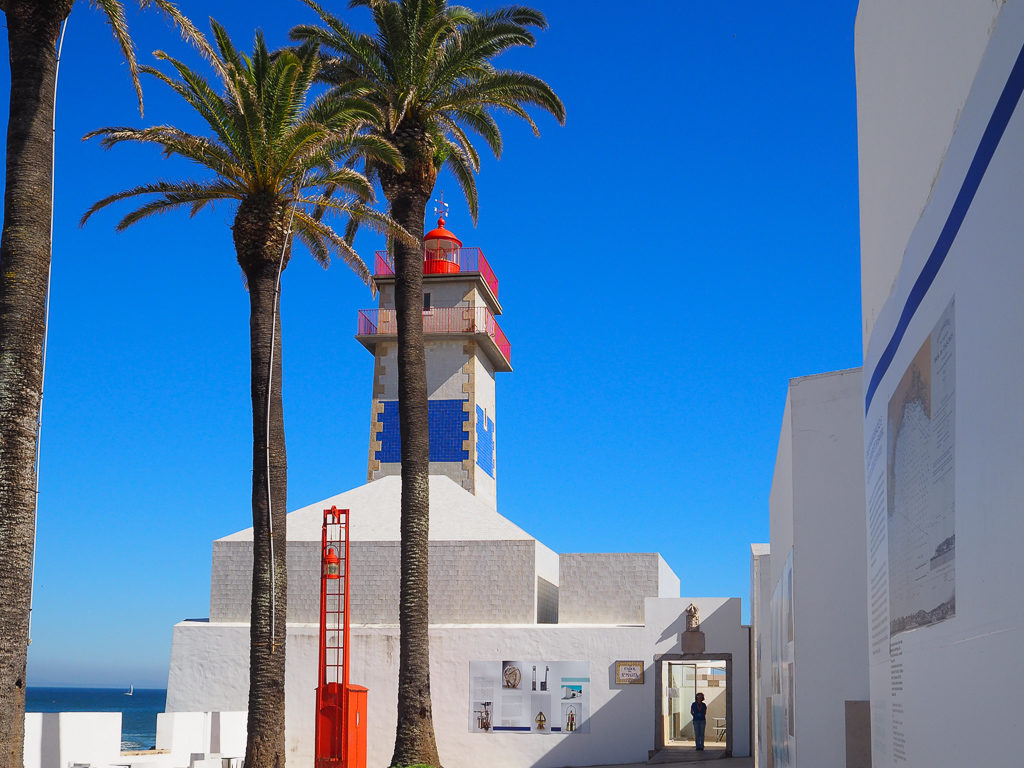 The lights are automated these days and the keepers’ accommodation is now a contemporary museum. The views from the top are lovely and the museum sheds light on the history of Portuguese lighthouses and the keepers’ lives. Check here for opening times.
The lights are automated these days and the keepers’ accommodation is now a contemporary museum. The views from the top are lovely and the museum sheds light on the history of Portuguese lighthouses and the keepers’ lives. Check here for opening times.
13. See how high society lived in Cascais
Cascais has an impressive Museum Quarter. But, as well as more conventional museums, you can visit some of the opulent villas that were built at the turn of the 20th century. Taking a peak back in time inside a private house is one of my favourite ways of absorbing some local history. And these wonderful houses give you a hint of what life was like during the high society summers of Cascais’s golden age.
The Casa de Santa Maria, stands next door to the lighthouse and is included in the ticket price. It was designed in traditional Portuguese style in 1902 by an Irish aristocrat Jorge O’Neill. Check it out for the terrace views and gorgeous tiling.
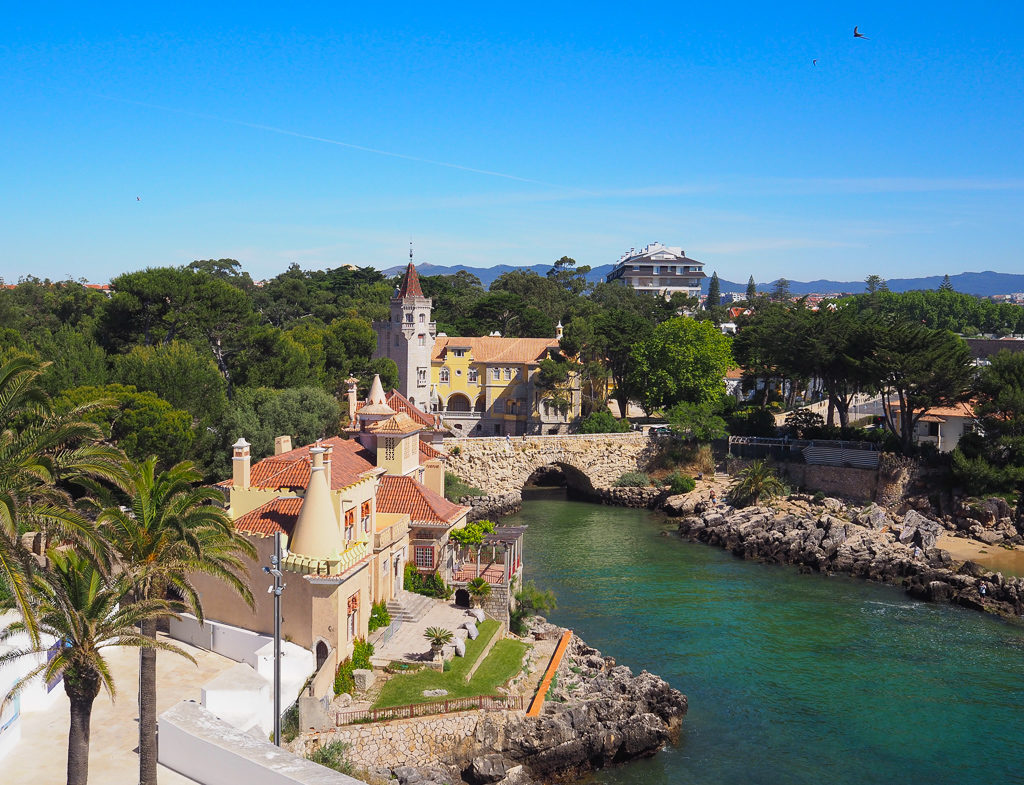
The grand Torre de San Sebastiao, now the Museu Condes de Castro Guimarães, is just across the road. A cheery buttercup yellow, this Revivalist style seaside home was also built by O’Neill as his own summer house. He indulged completely in its romantic, fantasy castle style. You can buy tickets on the door or get a good value 24 hour or 3 day museum pass which gives you access to all the sites on the Museum Quarter.
14. Relax in the Parque Marechal Carmona
The Parque Marechal Carmona is in the centre of town and includes the gardens of the Condes de Castro Guimaräes. It’s a peaceful spot with shady trees, wooded walks, peacocks, fountains and turtles in the pond. It’s one of the lovely free things to do in Cascais.
15. Step into the world of Paula Rego
For art of a very different sort, just a few minutes from O’Neill’s summer houses, is the utterly modern Casa das Histórias Paula Rego.
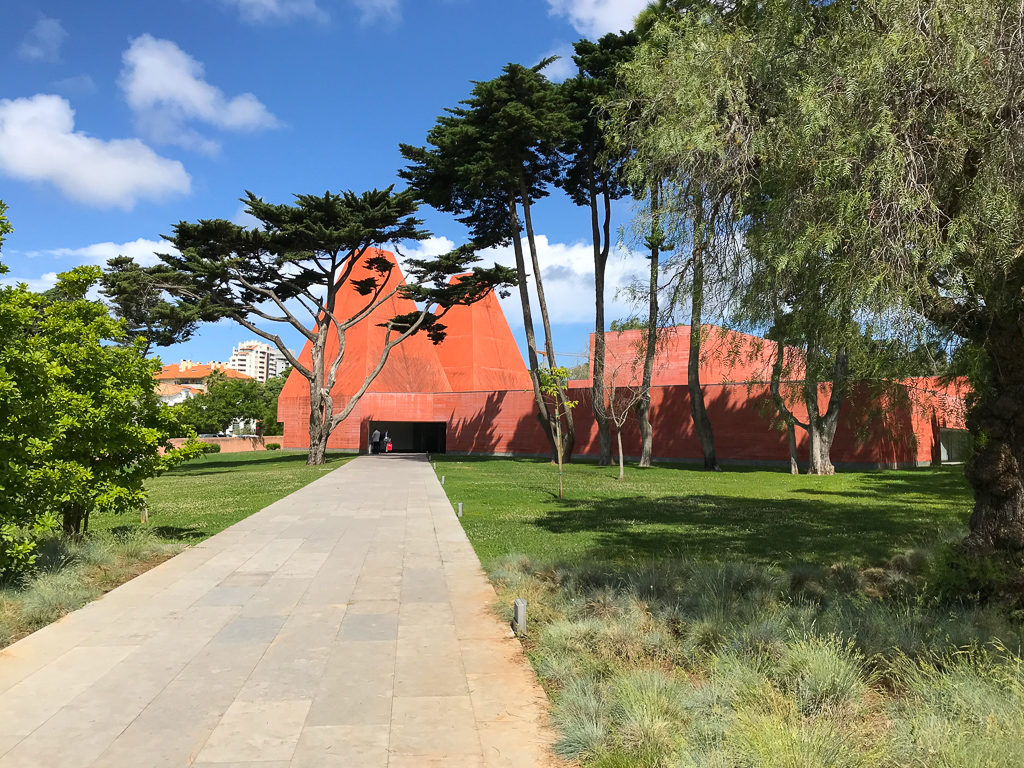 This House of Stories was built in 2009, its two towers echoing the chimneys of the Palace at Sintra. It’s a museum entirely devoted to the strange and thought-provoking world of visual artist Rego, who was born in Lisbon and died in London in 2022.
This House of Stories was built in 2009, its two towers echoing the chimneys of the Palace at Sintra. It’s a museum entirely devoted to the strange and thought-provoking world of visual artist Rego, who was born in Lisbon and died in London in 2022.
The galleries are easy to navigate with clear explanatory texts in both Portuguese and English. There’s a cafe too and a shop if you’re looking for some good quality souvenirs.
16. Walk to the Mouth of Hell: Boca do Inferno Cascais
A chasm and sea arch in the limestone cliffs along the Atlantic coast, Boca do Inferno, means Hell’s Mouth. In contrast to the calm coastline between Cascais and Lisbon, this stretch is open to the winds and currents of the Atlantic. On rough sea days, especially in winter storms, huge waves crash and boil around this break in the cliffs.
To be fair Boca do Inferno wasn’t really living up to its name on the afternoon we visited. It was more ‘a bit splashy’ than ‘ mouth of Hell’.
 But I can well believe that when the winds and waves rise it gets pretty diabolical.
But I can well believe that when the winds and waves rise it gets pretty diabolical.
Boca do Inferno is a 20 minute walk or a 7 minute cycle ride from the centre of Cascais. It has a few souvenir stalls and a cafe alongside the cliffside viewing platform. It’s one of the fun free things to do in Cascais, whatever the weather.
17. Discover Cascais’s seagoing heritage
Even before it was discovered by the aristocracy, Cascais was a thriving fishing village. The Museo do Mar or Museum of the Sea, named in honour of King Carlos, celebrates the town’s centuries old connections with the ocean. We dipped in to find a small and engaging collection that’s perfect for a cultural visit in between time on the beach.
A bathing hut stands on the lawn outside the museum with mannequins fully clothed for a day at the beach circa the early 1900s. Learn about marine life, gulls and the fishing industry as well as the Portuguese love of the ocean.
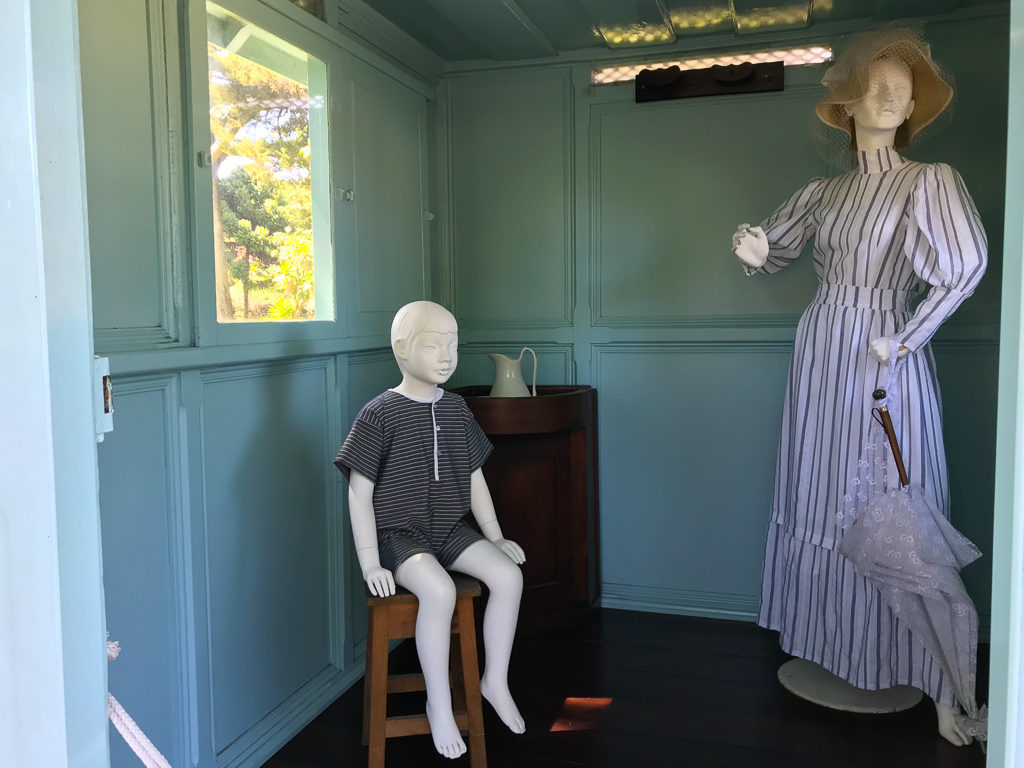
18. Visit the statue of King Carlos
You’ll find Dom Carlos I himself, binoculars in hand, surveying the harbour he loved, just outside the Citadel where he spent his Cascais summers.
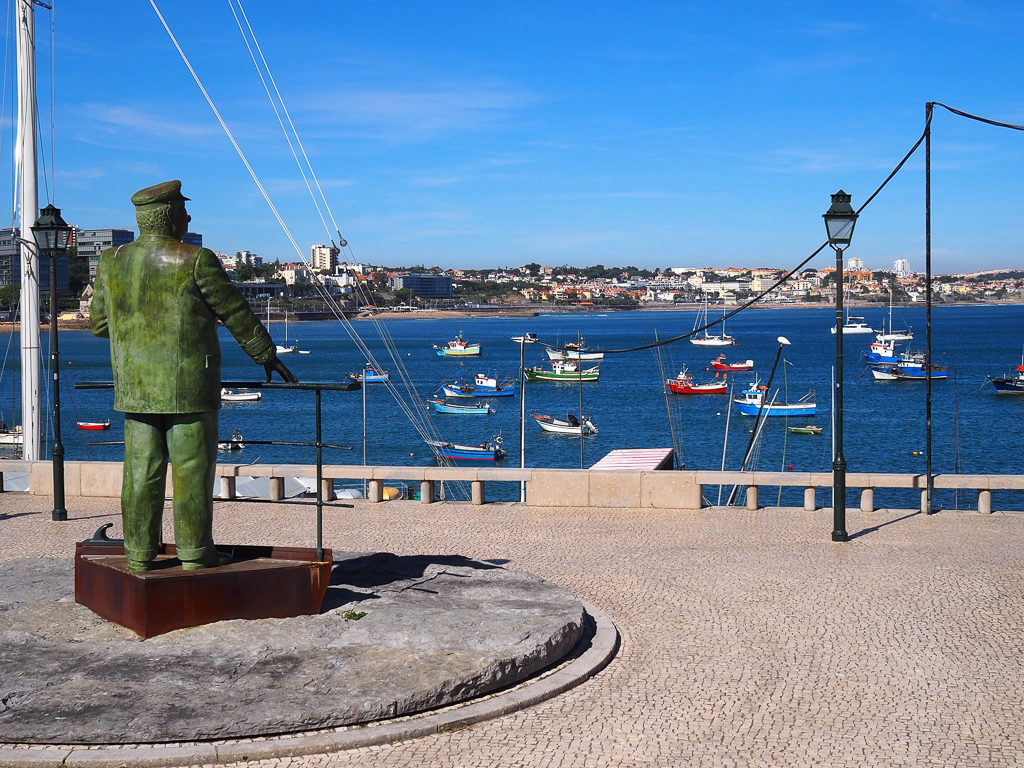 Born in 1863, he inherited his love for the sea from his father King Luis who gave him a yacht for his fifteenth birthday. King Carlos loved to sail and organised many regattas at Cascais. He was a keen fisherman, skilful marine artist and studied oceanography too.
Born in 1863, he inherited his love for the sea from his father King Luis who gave him a yacht for his fifteenth birthday. King Carlos loved to sail and organised many regattas at Cascais. He was a keen fisherman, skilful marine artist and studied oceanography too.
His sporting legacy lived on for many years in the shape of the Cascais Sporting Club which hosted tennis, cricket and even football matches during his reign. The original building is now the Museum of the Sea.
19. Try water sports in Cascais
We spotted kayakers in the harbour and surfers at Guincho but during the summer months there’s plenty more sea-based activities around Cascais. From sailing and diving to paddleboarding and kite surfing, surf schools, equipment and tuition can be found at the marina or on the surrounding beaches. On a sunny spring day quite a few people were braving the Atlantic waters to swim off the sheltered town beaches too.
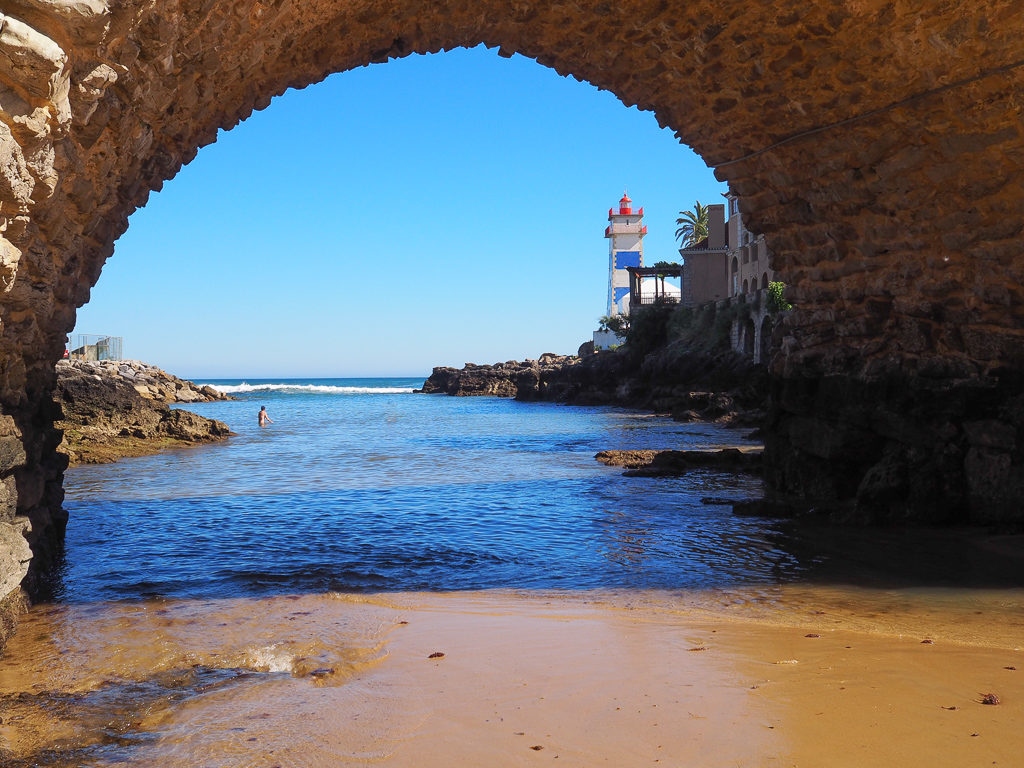
20. Play Golf in Cascais
Cascais is famous for its golf courses: Oitavos Dunes is rated as one of best courses in world, with dramatic links views for good measure.
Hotel Quinta da Marinha has its own course while Estoril golf club caters for beginners and tournament players alike and offers golf and spa packages. If you are a keen golfer then trying some of the seven local courses will be top of your list of Cascais things to do. Conveniently you can get a golf passport for the region.
Tennis and padel (a mix between tennis and squash) are also popular in the area.
21. Ride a bike along the coast to Guincho beach
In contrast to the town beaches with their calm seas and neat umbrellas and sunbeds, Guincho is altogether more rugged and windswept. A parasol wouldn’t stand much of a chance on this dramatic stretch of sand, backed by dunes and lashed with Atlantic breakers. Its wild vibe is protected as part of the Serra de Sintra National Park, and you really do get a sense that you’re on the westernmost edge of mainland Europe. From here you can see the absolute western tip, Cabo da Roca. It was once thought to be the end of the world.
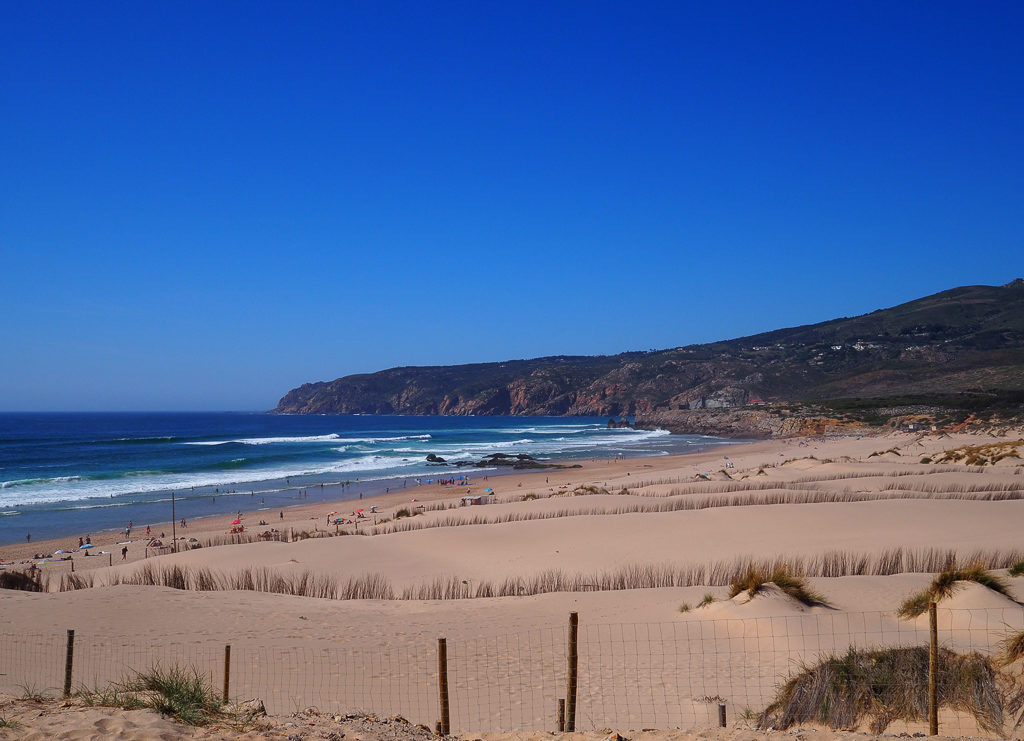
James Bond has been to Guincho of course, in the opening sequence of 1969’s On Her Majesty’s Secret Service. And it’s worth a visit for the scenery alone.
Guincho’s powerful currents mean it’s best left to the watersports experts, though it’s fun to watch. Cresmina beach next door is a little more sheltered for sunbathing. You can follow the boardwalks across the dunes and investigate the good restaurants near Guincho, as well as a beautiful hotel.
Hiring a bike and cycling along the coast road to Guincho is one of the top things to do in Cascais. On a windy day you might prefer an ebike, especially as there is a slight slope to the cycle path!
22. Visit Cabo da Roca, the edge of Europe
If you’ve rented a car then it’s worth taking the trip beyond Guincho to the most westerly point of Portugal, which is also the westernmost point of Europe. Cabo da Roca translates as Cape Rock which is a good description of this windswept headland with 100 ft cliffs, overlooking the Atlantic ocean. It has a handsome red and white lighthouse, a coffee bar and a souvenir shop where you can buy a certificate of your visit.
This is a great place to see a sunset and is included in the route of many local tours. It also has some challenging hiking trails, although you’ll need weatherproof kit, this is the edge of Europe after all!
23. Take a trip from Cascais to Sintra
I’d read so much about Sintra that a visit, even for half a day, was an absolute must. Just as Cascais was the beach resort of choice of the Portuguese royal family, so Sintra was their countryside escape. It’s now a UNESCO World Heritage Site and one of the best day trips from Cascais.
In 1838 King Ferdinand II restored an abandoned monastery with the help of architect Baron von Eschwege. He transformed it into a romantic palace with parkland which is now the world famous Pena Palace.
Sintra has several other extraordinary palaces and mansions but we decided to focus on just two sites, Pena Palace and the Capuchos convent.
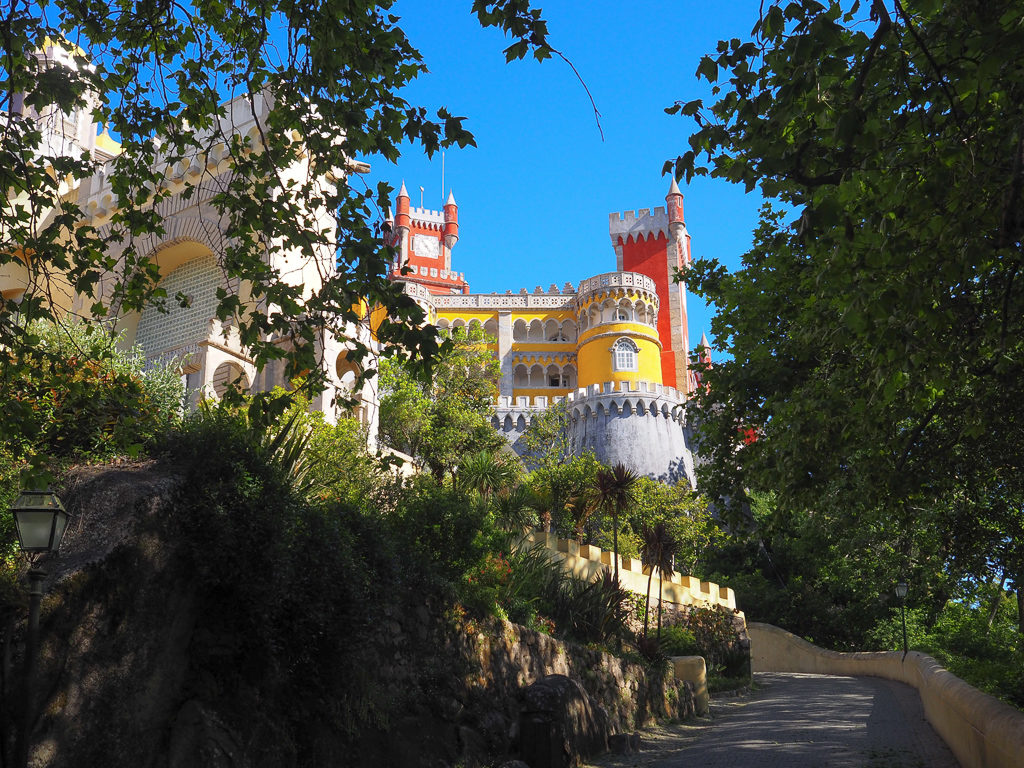
24. Pena Palace Cascais
A colourful riot of architectural styles, Pena Palace is amazing and intriguing. If you want to see it without throngs of visitors, then you need to get to Sintra early. This was the top-most tip from our friend and guide, Eva who drove us to Sintra. The journey from Cascais to Sintra took about 25 minutes by car and we arrived, pre-bought tickets in hand, before the gates to the palace opened. Even so within half an hour the battlements were pretty busy.
We bought tickets for the terraces and gardens, not the interiors, but still spent a couple of hours here. The gardens are expansive and you can wander the little pathways, enjoying the viewpoints and walks that Ferdinand created.
25. Capuchos Convent Sintra
Next we moved on to Capuchos Convent on the other side of the Sintra hills. We were almost the only people there. Built in 1560, the convent was the remote home for an order of Franciscan friars. They insisted on a spiritual life of extreme simplicity. It was profoundly peaceful after the bustle of Pena, but just as fascinating. We walked around quietly, peering into the monks’ tiny cells lined with cork then paused in the peaceful courtyard. It was humbling to think that for hundreds of years travellers would stop here to rest and bring news from the outside world.
We visited Sintra with our excellent guide and friend, Eva Sanches. You can contact Eva to book at private tour at www.greatdayout.eu. Please mention Map and Family.
26. Take a day trip to Lisbon
Visitors to Lisbon often take day trips to Cascais. So we reversed the trend by spending a day in the city before we flew home. The train from Cascais to Lisbon makes it easy to pop back and forth between the two. The journey takes about 40 minutes although you can just as easily take a taxi.
On our final day in Portugal we drove into Lisbon then parked our bags at the station by Rossio square. And after a fun day of tiles, trams, views and city tales it was an easy hop by metro to the airport for our evening flight home.
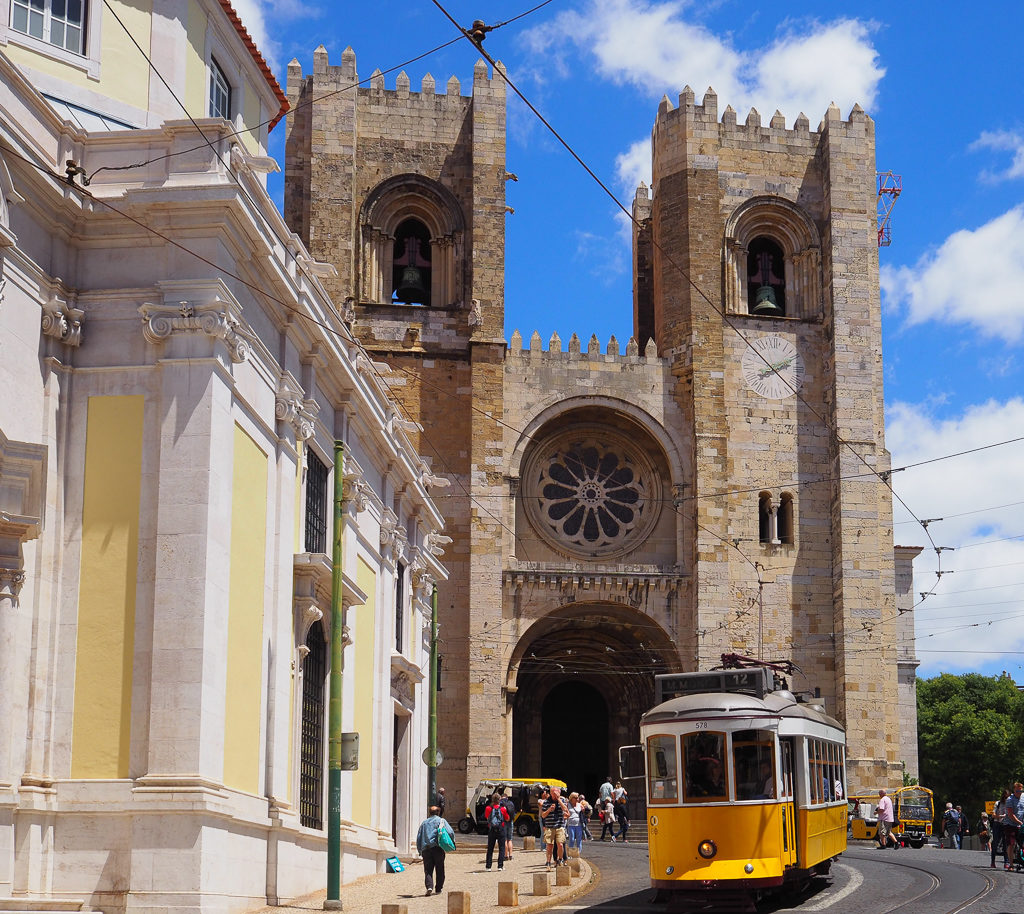
5 Free Things to do in Cascais:
- Visit all the Cascais beaches to pick your own favourite!
- Relax in the pretty Parque Marechal Carmona amongst shady trees, fountains and peacocks.
- Visit the Boca do Inferno, especially on a windy day, to watch the waves crashing through the sea cave.
- Ramble the boardwalks through the dunes behind Cresmina and Guincho beaches. Take a picnic and watch the expert wind surfers and kite surfers on the Atlantic coast.
- Walk the promenade from Cascais to Estorial and on your return reward yourself (not quite free of course!) with an ice cream from Santini’s.
Map of the Best Things to do in Cascais
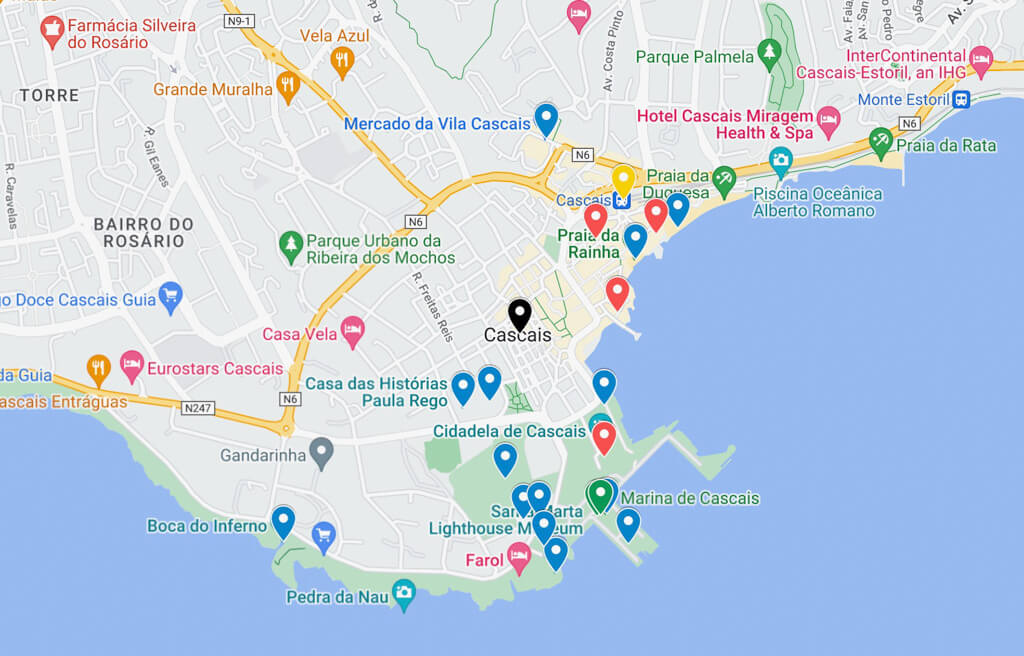
Please note that all visitor information here is for guidance only. Please check the venues’ websites for the most up to date information on tickets, entrance requirements, opening times etc.
HERE’S A SELECTION OF TICKETS AND TOURS FROM GET YOUR GUIDE
FAQs about Cascais
How do you pronounce Cascais?
In English Cascais is pronounced as Kash-kise.
When is the best time to visit Cascais?
Cascais Portugal has a mild climate year-round, although the best weather for visitors is between early Spring and late Autumn. For sightseeing, or playing golf, early spring and autumn are the best times to visit since temperatures are cooler than in high season. The hottest and driest months are mid-June to late August when the sun is intense and the town and beaches are very busy. Since Cascais is close to the Atlantic ocean the sea water is always quite cold, but in summer cool breezes at night can also help alleviate the high temperatures.
During the winter, the weather in Cascais can be more rainy and chilly, but off shore winds create powerful waves and excellent conditions for the most experienced surfers and kite surfers.
How do you spend a day in Cascais?
Wondering what to do in Cascais for a day? Order coffee and delicious freshly baked Portuguese pastries for breakfast in a little cafe. Pop to the beach to catch some sun for an hour or two, or explore the beautiful Old Town of Cascais, spotting historic tiled walls and pretty boutiques. Enjoy fresh fish for lunch at the market or one of the restaurants in the marina. Then immerse yourself in the wild world of Paula Rego at Casa das Histórias or climb the Santa Marta lighthouse. Take a sunset cruise along the coast or walk the promenade to Estoril for cocktails.
 Like this post? Please use this image to save and share on Pinterest
Like this post? Please use this image to save and share on Pinterest
Disclosure: with thanks to Visit Cascais for hosting a fascinating day’s introduction to Cascais. Our excellent tour, with André of Shortcuts Tourism, included visits to the Santa Marta lighthouse and the Museum of the Sea, a boat trip with Aquastart.pt and lunch in the Marina at Gordinni’s. Thanks also to the Paula Rego museum for entry and the catalogue of the current exhibition.
What to read next
Destinations that combine beaches and culture are my favourites for weekends away and out of season breaks.
Spend a fun long weekend in Barcelona, Spain which combines both beautifully. Like Cascais, it offers quick transfers from the airport to minimise time spent travelling.
If you’re interested in Barcelona then check out the fabulous Gaudi buildings, they’re an intrinsic and fascinating part of the city.
Naples, Italy is a fabulous city by the sea as well as being the gateway to the stunning Amalfi coastline, hidden islands and the treasures of Pompeii.
Dubrovnik in Croatia is another wonderful and historic city with fabulous beach life too. Here’s how to spend a week in and around Dubrovnik.
While Cape Town South Africa is a classic long-haul option offering beaches, rich culture and an amazing food and wine scene.
All photos are all rights reserved. Please do not reproduce these photos without prior written permission.
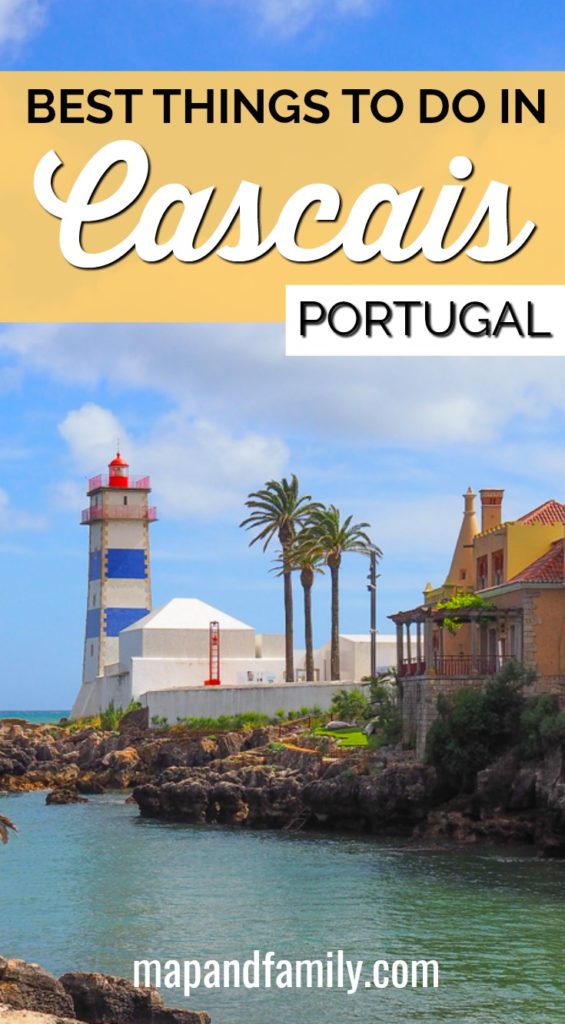 Like this post? Please use this image to save and share on Pinterest
Like this post? Please use this image to save and share on Pinterest

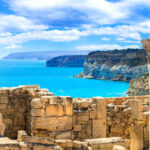

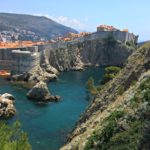
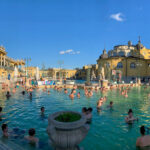
Scarlett Roitman says
Thanks for this fantastic tour of Cascais. Having spent so many years working in southern Portugal, I never actually spent enough time in Cascais. The Bulhao Pato clams is one of my all-time favourite dishes, and I had no idea about the egg yolk/egg white story. Explains a lot as the Portuguese use so much egg yolk in their desserts. I’m hoping to head over to Lisboa soon, so this blog will certainly be very handy when the time comes! Thanks for linking up with #CULTUREDKIDS
Map & Family says
I was really interested in the egg yolk story too – it makes complete sense – and there are so many delicious pastries to try there. We had a quick look at Lisbon and I’d love to go back.
USHA SITAARAAM says
Such a lovely post. I have been to Lisbon, but did not manage to go to Sintra as well. This makes me want to go back to Portugal and visit Cascais. The custard tart looks so tempting. Beautiful photos, my favourite is of the light house. #culturedkids
Map & Family says
Thanks, the lighthouse is beautiful from every angle! I certainly want to go back to Portugal.
Catherine’s Cultural Wednesdays says
I have been to Lisbon and Sintra but never Cascais something that I obviously need to rectify #CulturedKids
Map & Family says
They are a great threesome, but Cascais does have enough to do to warrant a weekend – or longer!
FRANCESCA NONE SPARACO says
Thanks for this fantastic post about Cascais. I have been to Lisbon and Sintra but not yet to Cascais. i have a few friends that love surfing and send me pictures about this lovely place all the time… I’m hoping to head over to Portugal soon!
Map & Family says
Thank you very much – I hope it’ll be useful! I’d like to go back to Portugal too, this visit was a great taster and I’m keen to see more.
Kathryn Dickson says
I wish I had read this BEFORE I went to Cascais for a few hours with my kids! Great information for next time.
Map & Family says
Thanks so much! Hope you get the chance for another visit
Allison says
Cascais is definitely on my travel wishlist. Your post is just solidifying that I absolutely want to visit some day. #farawayfiles
Clare (Suitcases and Sandcastles) says
Oh I really need to visit Cascais! We absolutely loved Lisbon and Sintra and I’m longing to explore more of Portugal. It looks so charming and much less built up than I’d imagined. Your guide is really informative. Thanks so much for sharing it on #farawayfiles
Janis says
Lovely post, we visited Cascais a couple of years ago, you had far better weather than we did, it outs a whole new light on the town. #farawayfiles
Tara says
That lighthouse would be enough to get me there but the rest of it looks amazing too. Thanks for sharing. #farawayfiles
Caity says
I visited Portugal for the first time a couple of years ago and absolutely loved it. I didn’t make it to Cascais but it’s definitely on the list for next time. A beautiful city next to such amazing coastline – Lisboners are a lucky bunch! #farawayfiles
California Globetrotter says
Ooh thanks for introducing me to Cascais! There’s so much of Portugal I want to see and laying out on that beach under the sun umbrellas looks pretty good right about now! #FarawayFiles
Map & Family says
I’d love to be on a beach right now too! I’m also keen to explore more of Portugal and I’ve more posts coming up soon 😀